February 2024
The Sky Tonight - February 2024
March brings us into the latter part of Bunuru, the second summer. The evening sky shows Orion and friends in the northwest …
ExploreThe Sky Tonight is a monthly update of the amazing things you can find when looking up from here in Western Australia.
April brings us into the season of Djeran, characterised by arrival of some much-needed cooler nights. The eastern sky is the place to look this month with Leo and Hydra visible in the evening. These constellations are somewhat faint but should still be discernible to a good eye largely because the pattern of stars within them looks something like what the artistic interpretation represents. They are joined later in the evening by Virgo, with its brightest star Spica to guide the way.
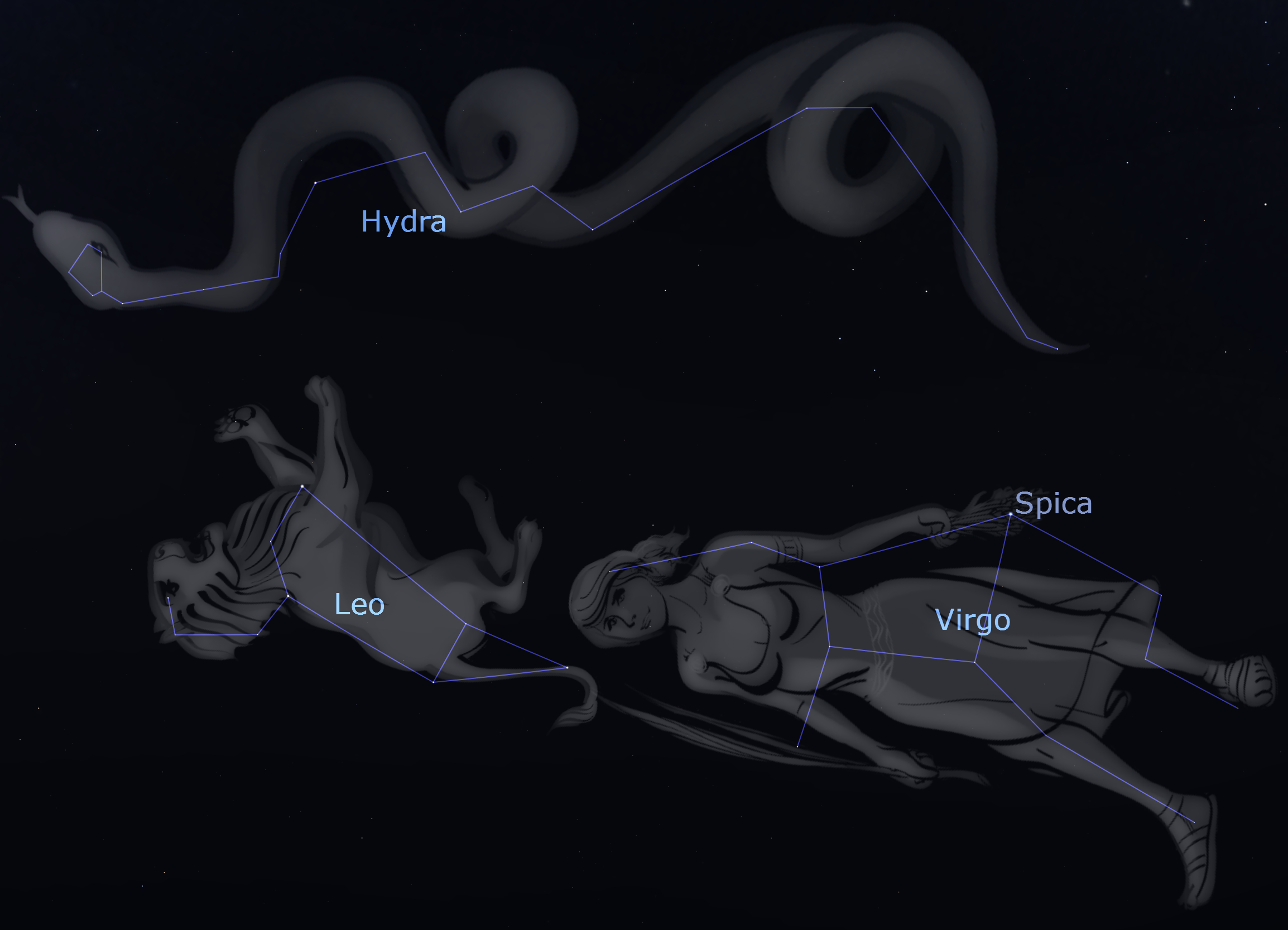
Credit: Stellarium
If you are up later, Scorpius is rising about 10pm bringing with it some of the brighter areas of the Milky Way which makes for good viewing into the early hours of the morning.
Mars and Saturn have a very close approach on the morning of Apr 11, passing within less than half a degree of each other. Head outside before sunrise and look to the east to see this.
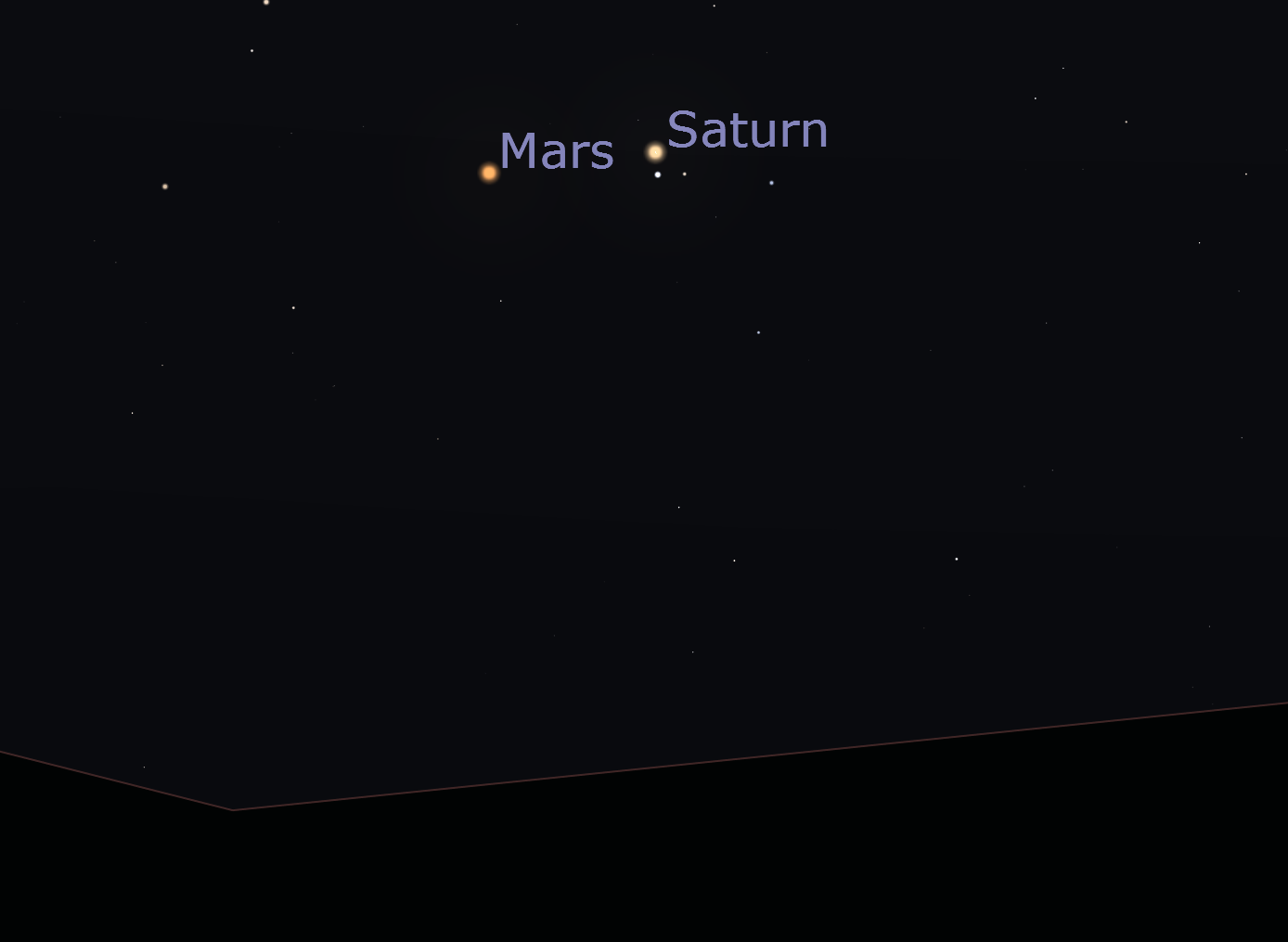
Credit: Stellarium
You will probably hear about the total solar eclipse taking place in North America on Apr 8, where the Moon will pass between the Sun and Earth and cast a 185km wide shadow on our planet. This eclipse begins over the Pacific Ocean and moves northeast over Mexico, the USA and Canada. Observers in the path of totality – the collective path on Earth where the Moon’s shadow passes – will experience about 4 minutes of darkness as the shadow races across the Earth’s surface at about 2650km/h. You really should click this link to see a NASA simulation of the event.
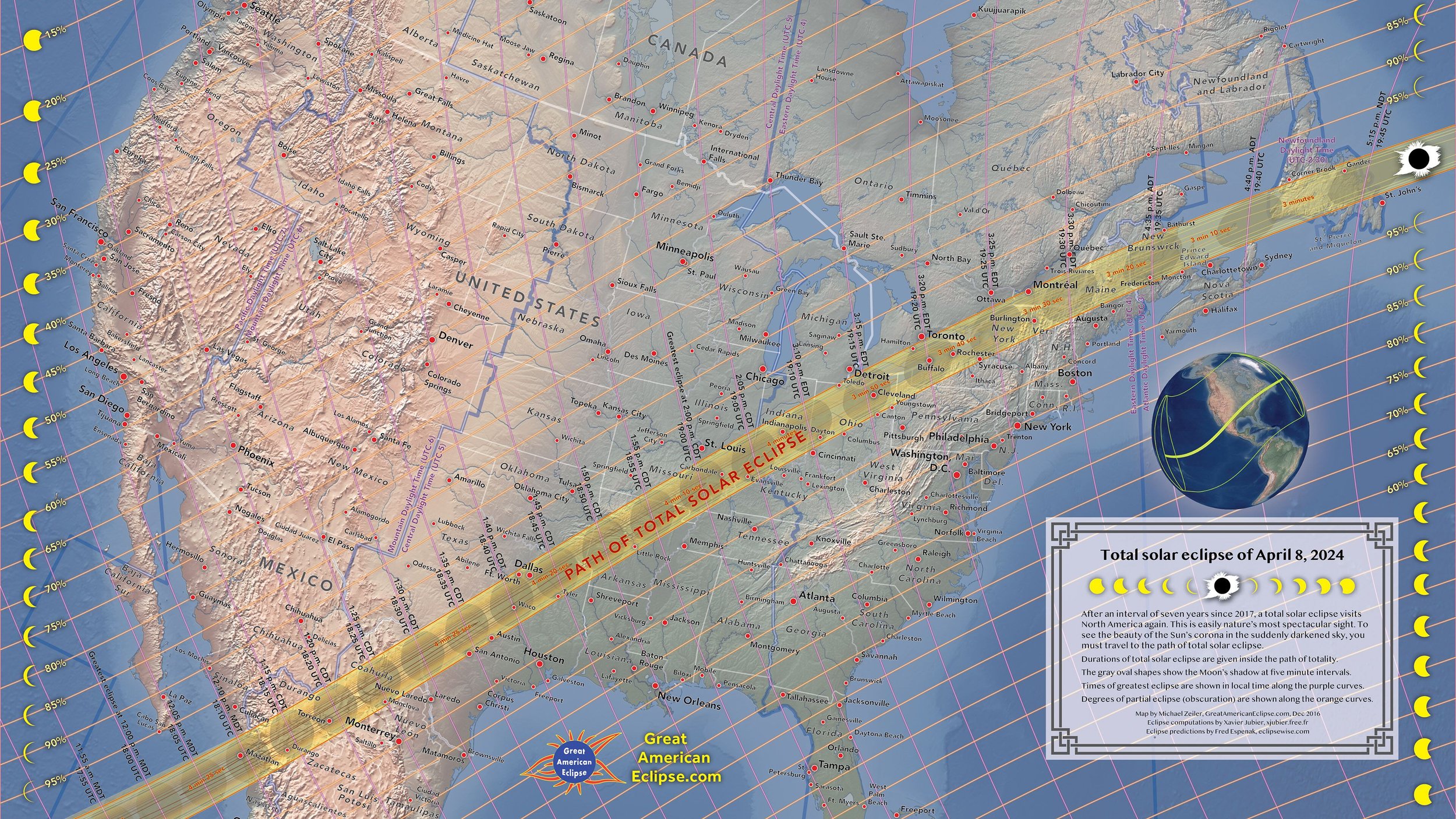
Credit: Michael Zeiler, GreatAmericanEclipse.com
This eclipse is the sister of the partial lunar eclipse on March 25. Unfortunately, the eclipse is not visible from Australia at all, occurring on the other side of the world from us and beginning in the very late hours of the evening of Apr 8 and finishing in the early hours of the morning on Apr 9, AWST.
In case you are wondering, the next total solar eclipse visible in Australia is in 2028 on Jul 22. The next total solar eclipse to pass directly over Perth will occur on May 31, 2068, with totality lasting a miniscule 33 seconds.
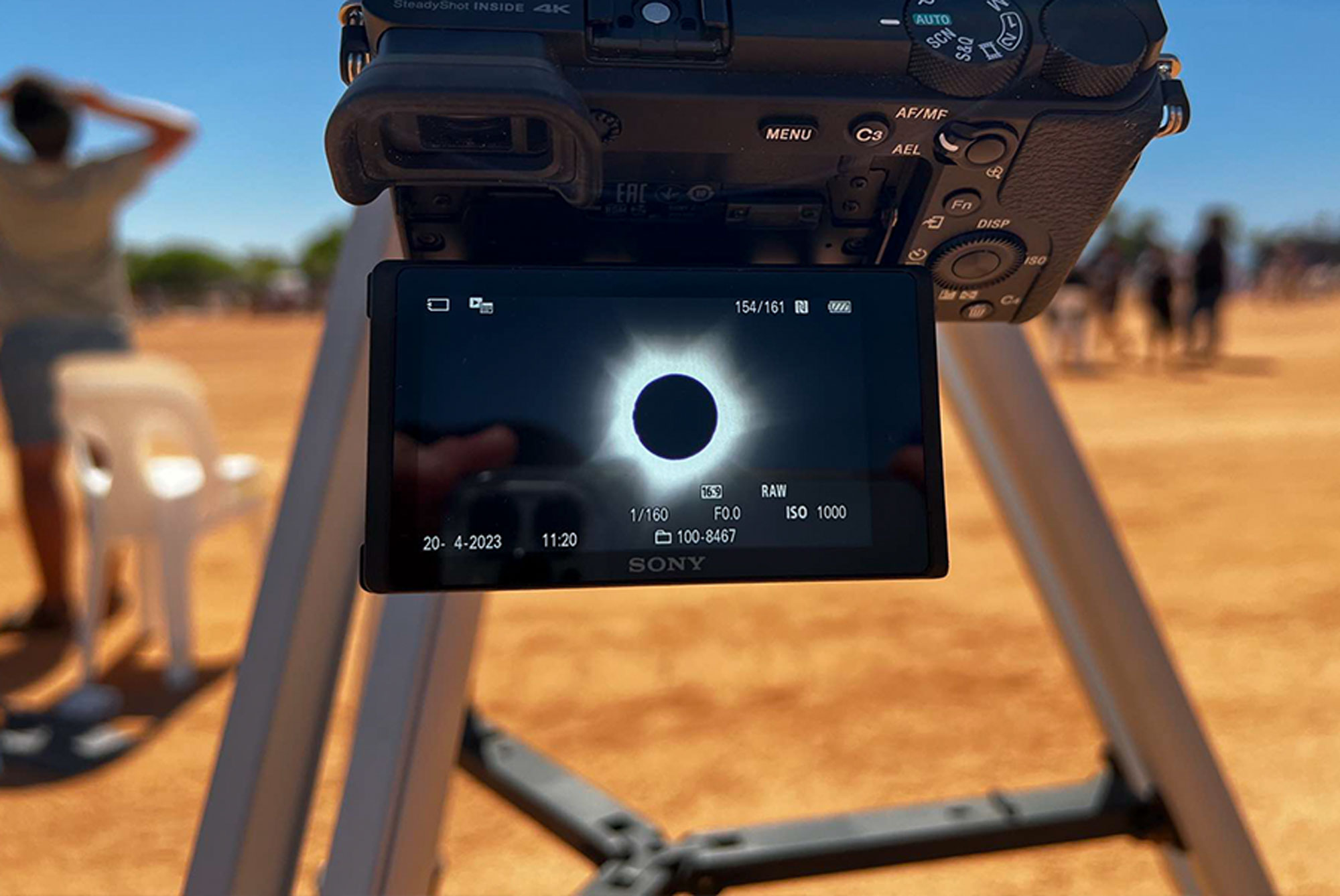
Credit: Dr John Chappell, Scitech.
ISS sightings from Perth
The International Space Station passes overhead multiple times a day. Most of these passes are too faint to see but a couple of notable sightings* are:
| Date, time | Appears | Max Height | Disappears | Magnitude | Duration |
| 7 Apr 5:58 AM | 10° above SW | 68° | 10° above NE | -3.7 | 6.5 min |
| 14 Apr 6:35 PM | 10° above NW | 69° | 10° above SE | -3.8 | 6.5 min |
Table: Times and dates to spot the ISS from Perth
Source: Heavens above, Spot the Station
*Note: These predictions are only accurate a few days in advance. Check the sources linked for more precise predictions on the day of your observations.
Scitech will be launching a bee petting zoo exhibition
April 1
Moon close to Mars and Saturn in morning sky
April 6
Total solar eclipse in North America
April 8
Mars and Saturn very close approach
April 11
We have a problem of geometry this month:
Image: Relative positions of solar system objects on Apr 15, 2024. Object size not to scale.
Credit: Scitech/Smith
The lines of sight from Earth to all the planets pass close to the Sun, meaning the planets are only visible near sunrise or sunset, less than ideal circumstances.
Mars and Saturn make for interesting viewing in the eastern sky in the hour before sunrise. Keep an eye out for their close encounter on Apr 11. In the coming months Saturn will rise steadily higher as it moves from east to west, while Mars will make a much more leisurely pace, hanging around the ENE morning sky for the next 5 months before appearing to make any dramatic movement across the sky.
Venus is also out in the east but is only briefly visible before the Sun appears and washes everything out.
Mercury is passing between Earth and the Sun this month, meaning if you want to look at Mercury you need to look in the direction of the Sun, also known as ‘daytime’. Jupiter is visible in the northwest for an hour or so after sunset but is soon to pass behind the Sun.
Puppis is a largish constellation located in the southern celestial hemisphere and visible in the western sky during April evenings. The constellation represents the stern of the Argo Navis, the great boat of the sky and a favourite of this website and planetarium. The Argo Navis was originally a single giant constellation before being separated into Carina, Puppis and Vela in the 18th century.
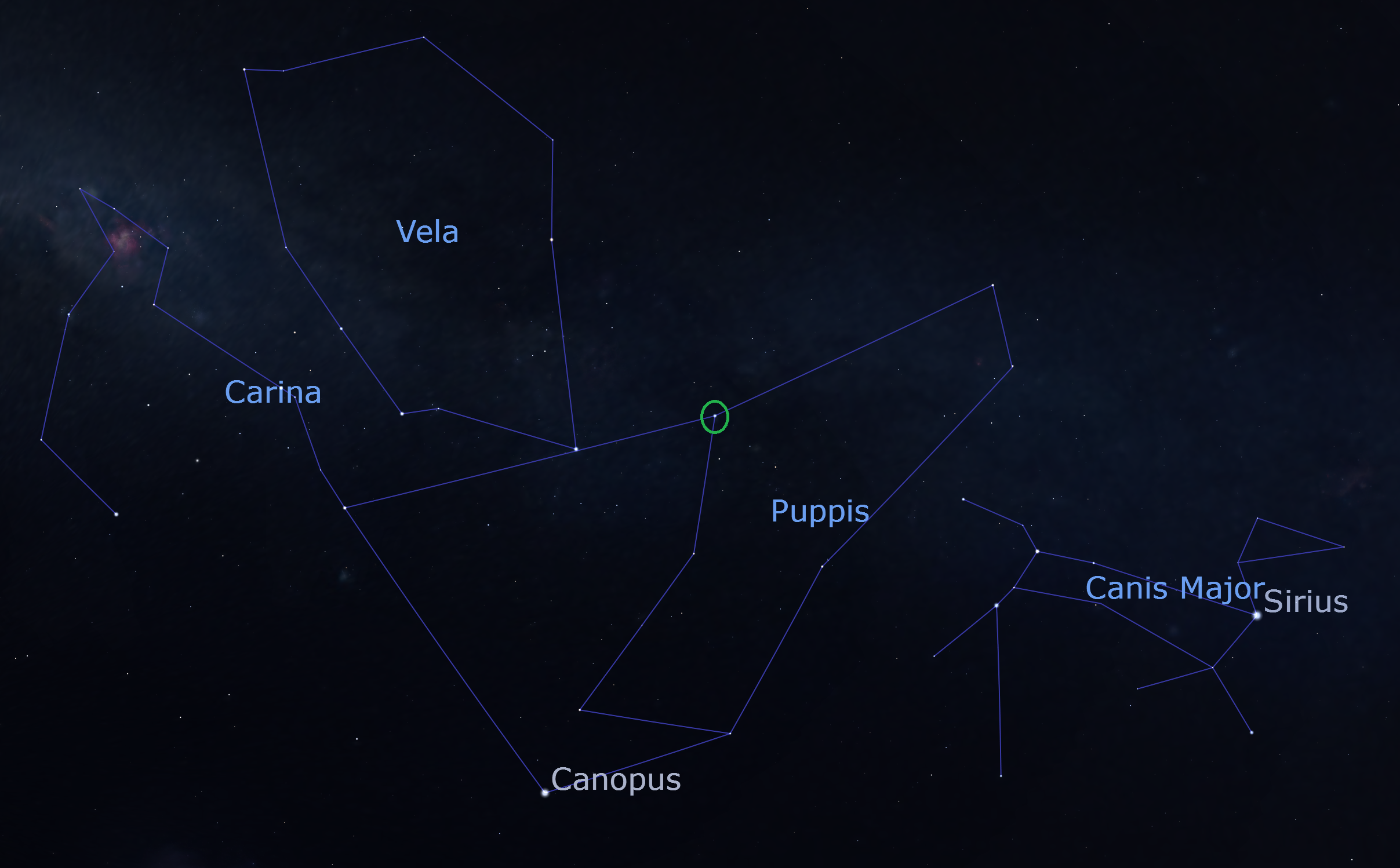
Credit: Stellarium
Puppis is located between Canis Major and Carina, marked by the two brightest stars in the night sky, Sirius and Canopus respectively. In case you are wondering, the name Puppis derives from the French word ‘la poupe’, referring the elevated deck on the stern of a boat intended to add buoyancy to the rear of the vessel.
The brightest star in Puppis is the star Naos, fittingly meaning ‘ship’ in ancient Greek. Interestingly, the Bayer classification system – the practice of assigning star names using letters of the Greek alphabet in order of brightness, eg Alpha Centauri, Beta Centauri referring to the two brightest stars in Centaurus, and so on – was not revised when the Argo Navis was separated into its three modern constellations. The stars in each of the three new constellations kept their original Bayer letter rather than getting a new one. This means that Naos, the brightest star in Puppis, is actually listed as Zeta Puppis, inheriting the letter Zeta it carried while part of Argo Navis. There is no star called Alpha Puppis. Canopus, the brightest star in the Argo Navis, carried the Alpha letter with it to become Alpha Carinae, the brightest star in Carina.
Image: Artistic impression of Zeta Puppis
Naos is an extraordinary star in every sense. It is an O-type star, the hottest of all main sequence stars, furiously burning hydrogen in its core. Coming in at 56 solar masses and about 20 times the diameter, the star emits more than 500000 times as much energy as the Sun, most of it in UV light, ironically making it not as visually bright as many cooler stars that emit more in the visible spectrum.
The Milky Way passes through Puppis meaning there are many star fields and clusters inside the boundaries of the constellation. This includes the Messier objects M46 and M47, open clusters containing about 500 stars each.
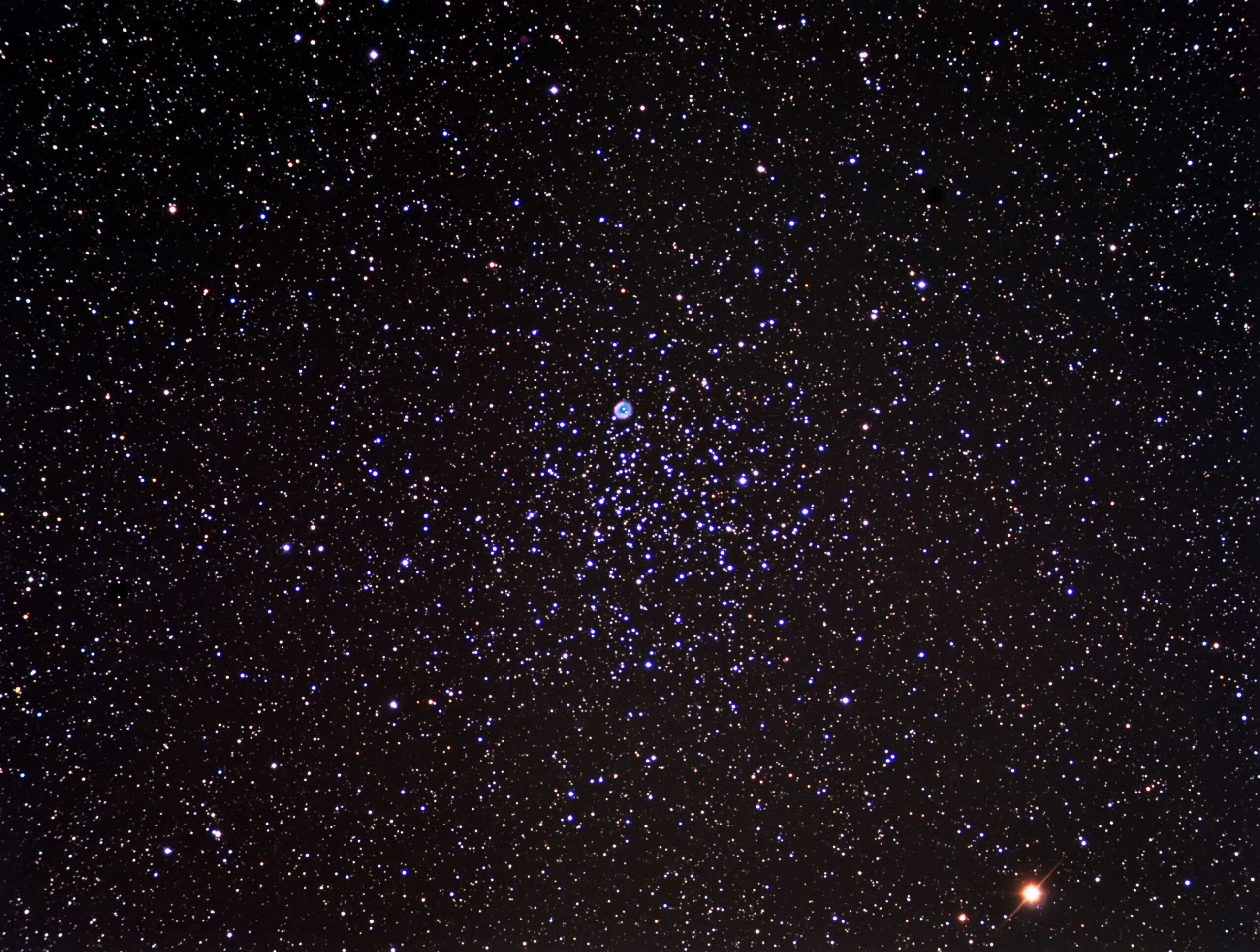
Credit: Jose Luis Martinez, CC BY-SA 4.0,
Near to M46 lies the Calabash Nebula. This spectacular object is the last gasp of a dying solar-mass star. As the red giant star ceases fusion it throws off its outer layers of gas. In this case, material is ejected in opposite directions (orange) and slams into surrounding gas (blue).
Image: The Calabash Nebula as viewed by the Hubble Space Telescope.
Credit: ESA/Hubble & NASA, Acknowledgement: Judy Schmidt
Over the next thousand years the object will evolve into a planetary nebula. The presence of large amounts of sulphur gives the object its nickname – Rotten Egg Nebula – because of the pungent smell sulphur compounds give to rotten eggs.
NGC 2451 – The Stinging Scorpion
Located inside Puppis, NGC 2451 is actually two open clusters of stars lying on the same line of sight. Centred on the orange star c Puppis, the naked eye stars bear a resemblance to a scorpion, making the pattern almost a miniature version of the Scorpius constellation.
Image: NGC 2451, with scorpion outlined.
Credit: Stellarium, modified by Smith/Scitech.
On March 14 SpaceX conducted Integrated Flight Test 3 (IFT3), the third test flight of the fully integrated Starship vehicle. The 121m tall rocket consisted of Superheavy Booster #10, upon which sat Starship #28. Notice that the word ‘Starship’ does double duty here as the name of the entire rocket and also the second stage. After a minor delay caused by uncertain weather conditions, the 33 engines of Booster 10 roared to life and 5500-ton Starship was away.
Watch Starship’s third flight test https://t.co/1u46r769Vp
— SpaceX (@SpaceX) March 5, 2024
Credit: SpaceX
A quick recap in case you haven’t been playing along at home: In April 2023, the first test flight, IFT1, ended shortly after liftoff when the whole rocket spun out of control and exploded. In November 2023 IFT2 successfully launched and performed stage separation, with the booster and Starship separating moments before the booster exploded, and Starship itself almost reaching orbit before a planned dump of excess oxygen caused an onboard fire and a rapid unscheduled disassembly of Starship over the Atlantic Ocean.
For IFT3 the main goal was to get Starship 28 to orbit. Secondary goals included soft landing Booster 10 and performing a number of tests of Starship once it was in orbit. Things got off to a great start with the vehicle successfully performing hot staging – when Booster 10 was almost out of fuel Starship ignited its engines and took off, basically launching a rocket from on top of a rocket. Onboard cameras, not available on previous Starship flights, showed this spectacular event unfolding.
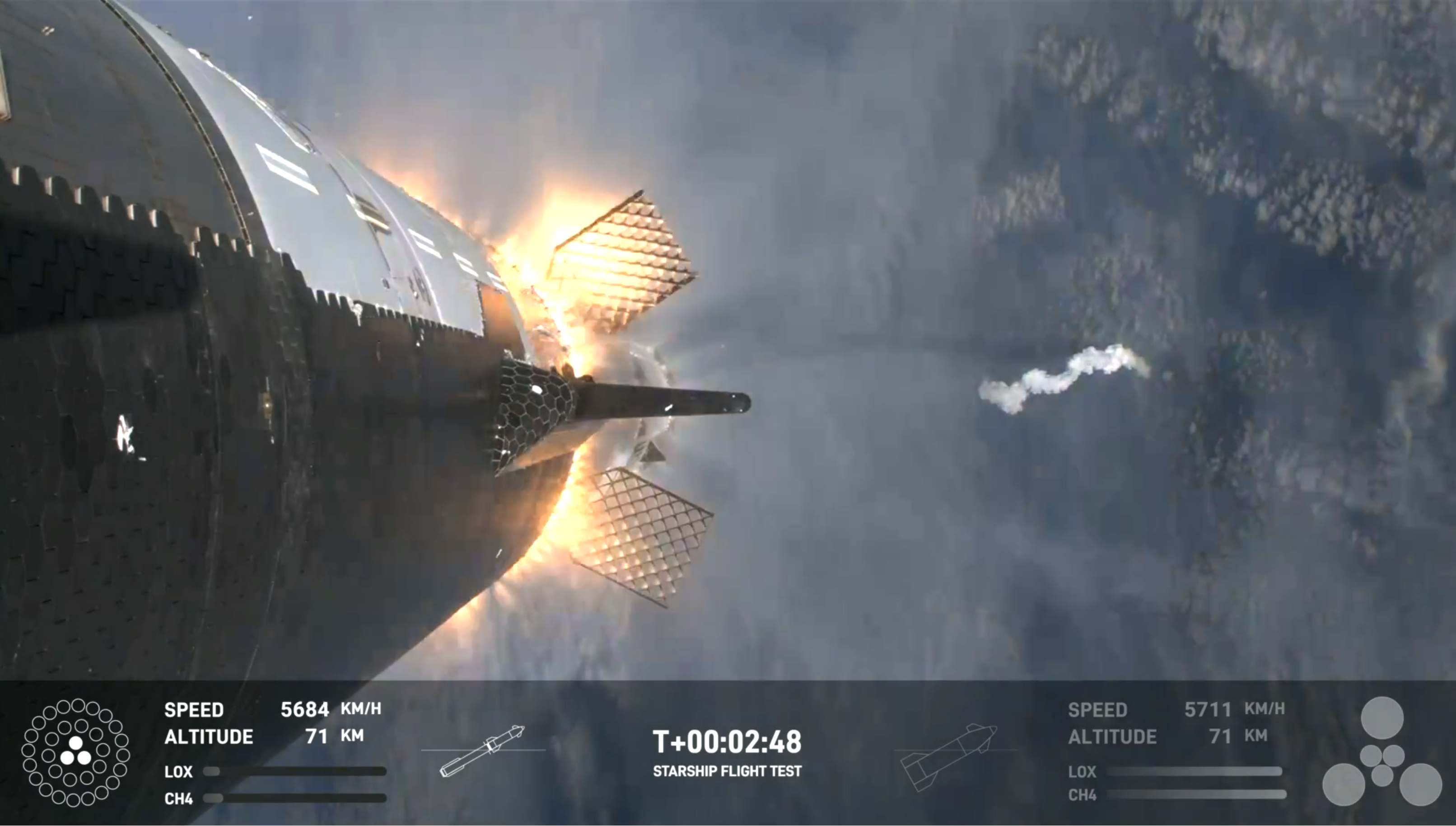
Credit: SpaceX
In the previous flight, IFT2, the booster exploded almost immediately after this hot stage separation, a result later attributed to blocked oxygen filters. SpaceX seemed to have solved this problem on IFT3 however, because Booster 10 was able to relight its central engines and boost back towards its launch site. The intention was to re-enter the atmosphere and fire its engines to slow down and gently “land” in the ocean in the Gulf of Mexico. Things seemed to go smoothly until the booster started spinning rapidly about 5km off the ground, still travelling about 1000km/h. Shortly thereafter the booster exploded, about 450m above the ocean.
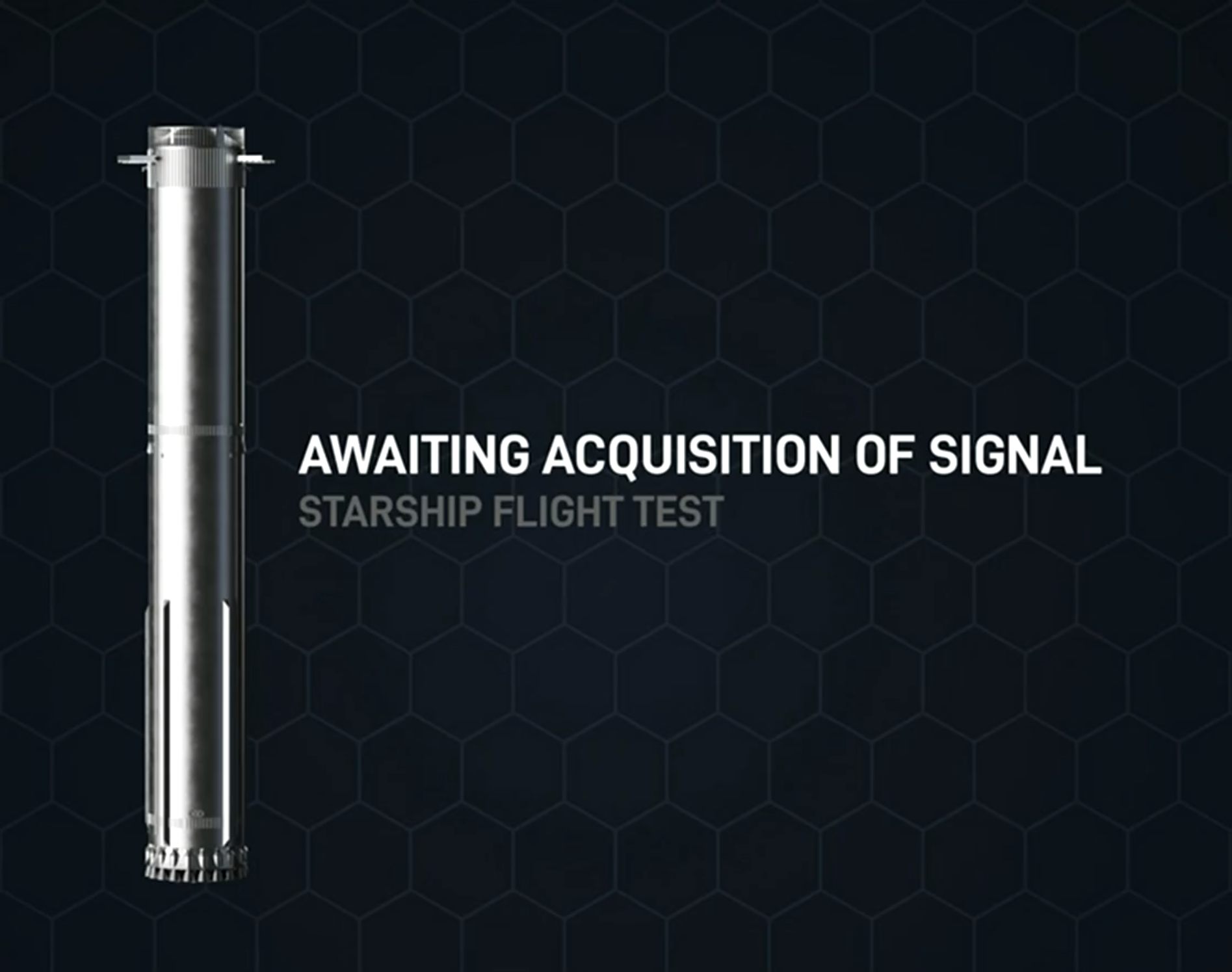
Credit: SpaceX
Meanwhile, Starship 28 continued its flight and successfully made it to space and shut down its engines a fraction before reaching orbital velocity. This was exactly as planned, as the suborbital trajectory would carry Starship over the Atlantic Ocean and Africa before re-entering in the Indian Ocean off the coast of Western Australia about 40 minutes later.
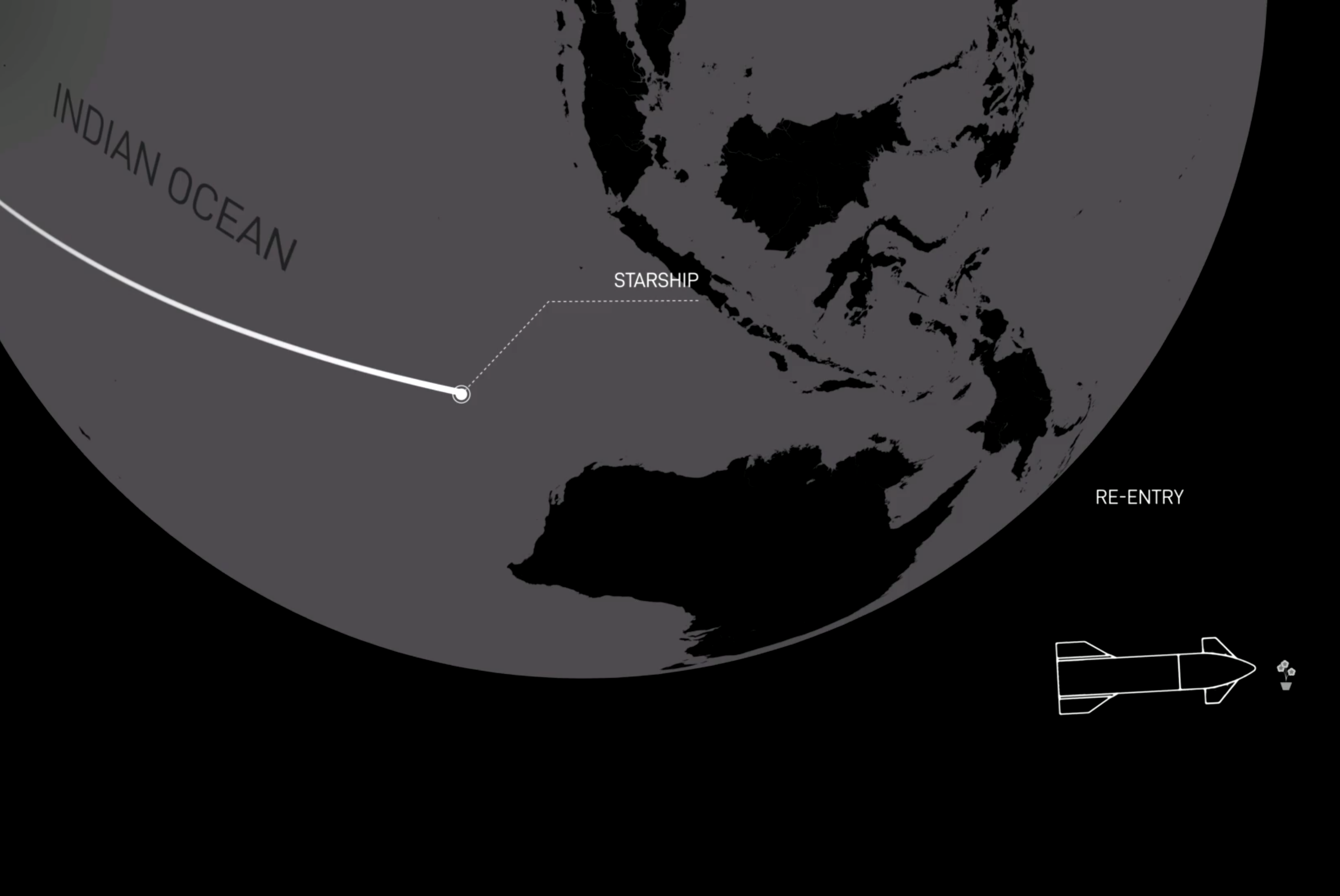
Credit: SpaceX
Several tests were conducted while Starship was in orbit. The payload door was opened, which in later missions will allow the spacecraft to deploy communications satellites for Starlink. SpaceX also reported they had successfully completed an onboard fuel transfer test, though it is unclear what the test involved. They were also planning to relight an engine while in space, but this test did not proceed because Starship had a bad attitude.
Specifically, Starship seemed to be tumbling around as it was in orbit. The direction a spacecraft is facing is called its attitude, which doesn’t necessarily have to be the same direction the spacecraft is moving, and SpaceX decided not to perform the engine relight test based on this information.
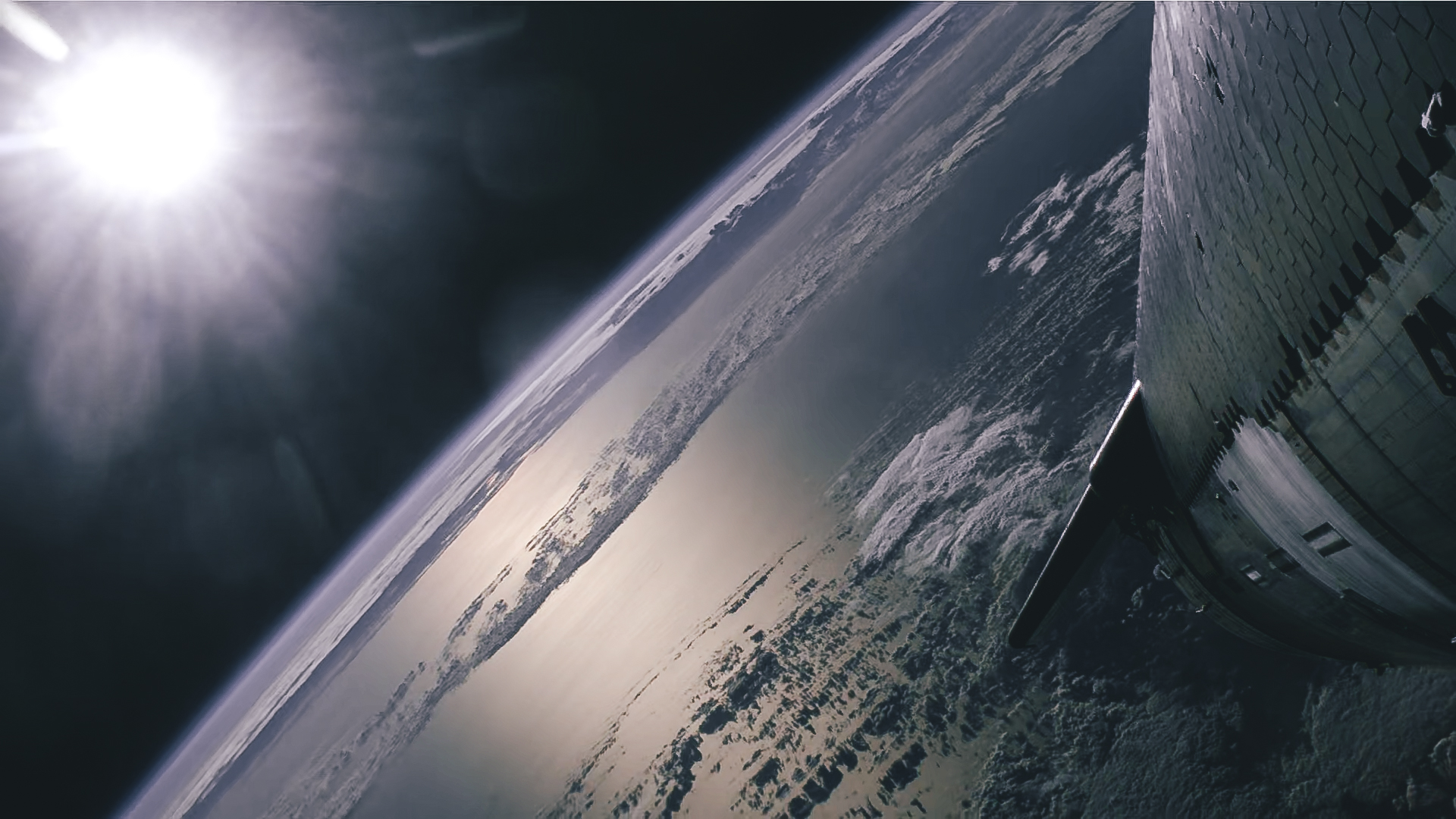
Credit: SpaceX
It appears there was some sort of problem with Starships ability to maintain attitude. As Starship began to re-enter the atmosphere, the vehicle is supposed to face its shielded side forward to protect itself from the fierce heat of re-entry. However onboard cameras showed the spacecraft hitting Earth’s atmosphere at all sorts of angles, which while very pretty, are not conducive to safe spaceflight.
Interestingly there was still live video feed from Starship for a surprisingly long time. Usually, communication with re-entering spacecraft is temporarily lost because the plasma that forms around the spacecraft blocks radio signals leading to a communications blackout. Starship is large enough that it punches a hole through this plasma, leaving a wake behind it like a boat does on water, and this in theory could allow continuous communication all through re-entry.
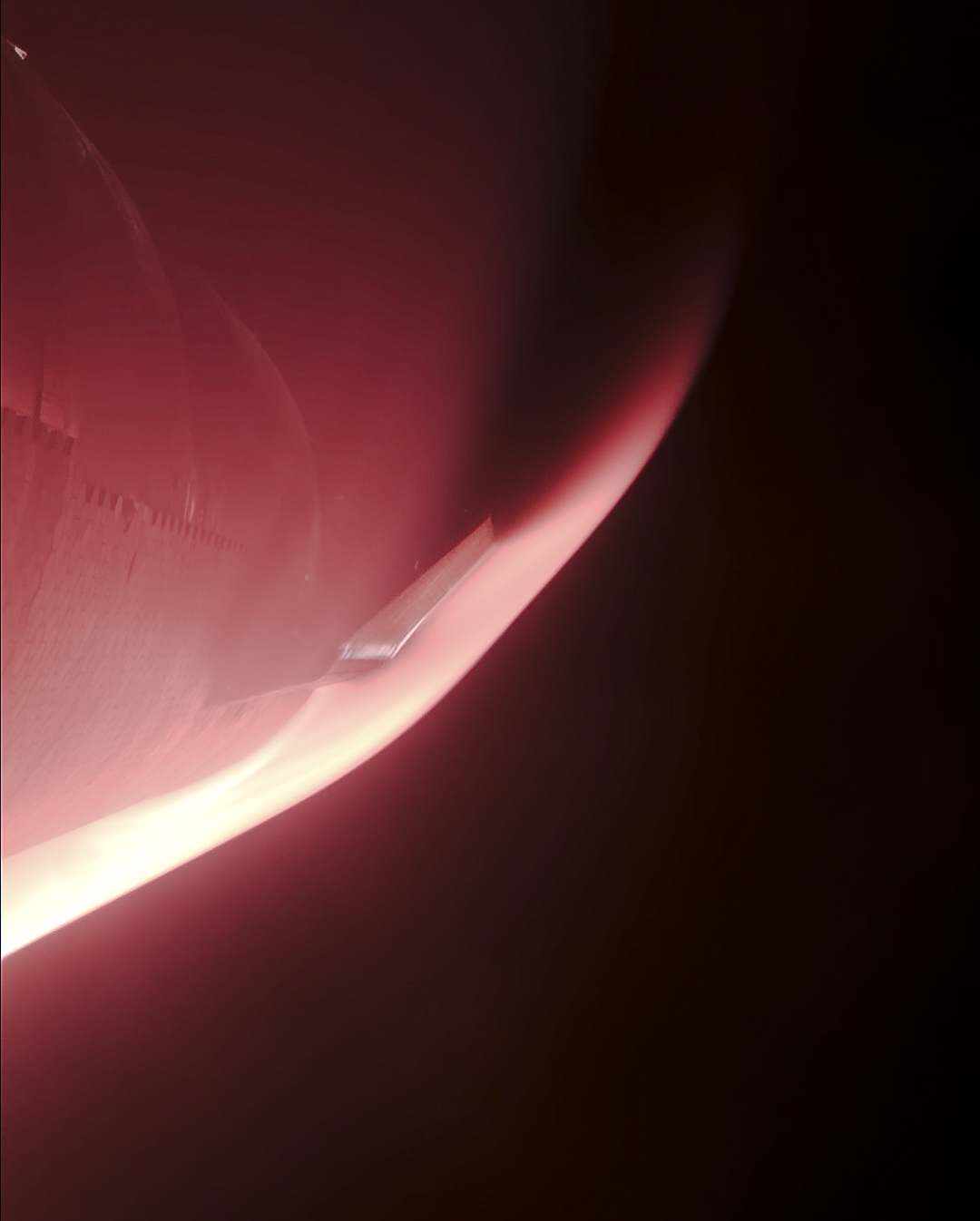
Credit: SpaceX
Not this time though. As science communicator Scott Manley quipped: “There are essentially two ways where you have a communications blackout due to plasma. The first is that plasma gets hot, electrons flowing around, they are conductive, they interfere with radio waves and the signal can’t get out. The other is where your communications equipment gets hit by the atmosphere and turns into a plasma and can no longer communicate.”
Long story short, after 40 minutes in space, Starship burnt up upon re-entry perhaps 65km above the ground and travelling at about Mach 21.
Image: The last recorded telemetry data from starship before communication was lost. Pour one out for the telemetry signals that never got to zero. Credit: SpaceX
As usual it is easy to look at this as a failure, but as usual that is a bit short sighted. IFT3 was more successful than IFT2 and will provide information that will guide IFT4, whenever that occurs. The fact that Starship got to orbit proves that SpaceX now has the capability to deliver 150 tons of cargo to orbit in a single launch, significantly more than any other rocket operating today. Ultimately, Starship will be used to return humans to the surface of the Moon, and possibly for interplanetary travel in the future. Watch this space(ship).
Upon clicking the "Book Now" or "Buy Gift Card" buttons a new window will open prompting contact information and payment details.